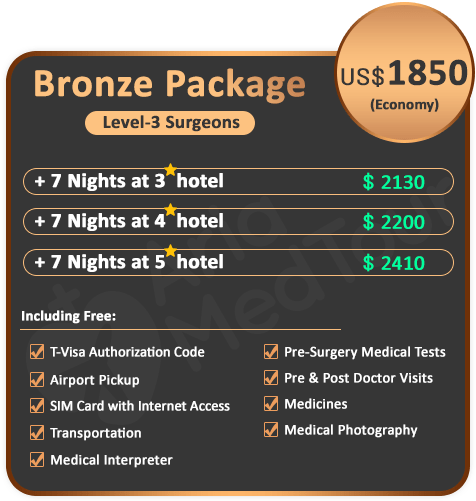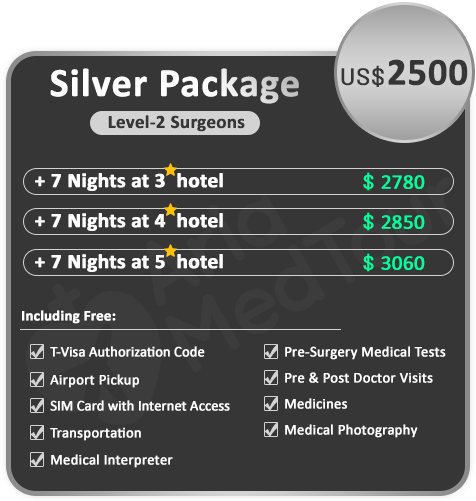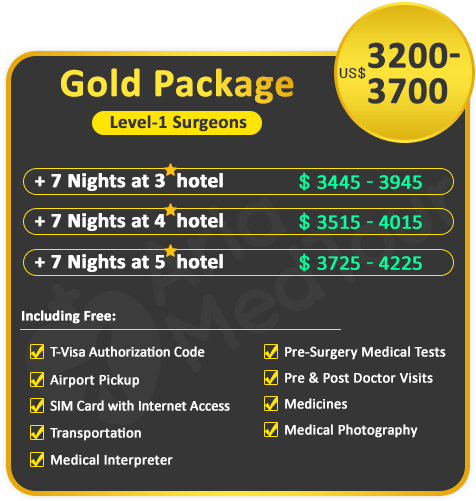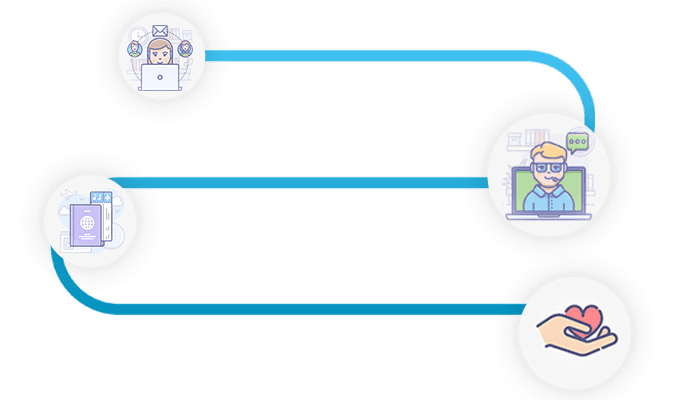Traveling abroad for nose surgery is not hassle-free if you want to do it on your own; that’s where we come into play. SinoheMedTour offers all the services you need for your nose surgery in Iran in affordable all-inclusive packages. The price of nose job packages is determined by the experience and proficiency of the doctor, type of hotel, and other services you wish to receive.
PRIMARY RHINOPLASTY PACKAGES IN IRAN



* What does a surgeon level mean?
Our rhinoplasty packages have been classified into 3 levels mainly based on the surgeons’ competencies and also the hospital/clinic where the surgery takes place.
Our surgeons’ ranking is measured using different criteria, including:
- Skills and hands-on experience, evaluated based on the years of experience as a surgeon, the number of successful surgeries, the percentage of patient satisfaction, and expertise in fleshy nose surgeries.
- Academic background, evaluated based on the education level (considering their specialties and subspecialties), ranking in the board certification examination, the place of study (institution ranking), and the number of congresses, workshops, and courses attended.
The higher-ranked surgeons are the Iranian brand doctors who are also active on social media.
* Note that all our doctors are board-certified and have met SinoheMedTour medical group’s standards.
WHAT WE OFFER
- Rhinoplasty
Clinic and doctor visits, medical tests, medical photography, nose surgery in hospital, post-operative care, medicines*, recovery, and follow-up
- T-Visa Authorization Code
T-visa authorization code. (Note that there is a separate visa fee that the patient must pay when receiving the visa, which it is not part of this package).
- Pick-up & Transfer
Airport pick-up, private transfer from hotel to clinic/hospital and vice versa
- Accommodations
7 nights stay in a three-star to five-star hotel offered which is preferably near the clinic or hospital - Other Services
24-hour on-call assistance, interpreter, SIM card and internet
Note: The medicines and other aftercare items included in this package are the necessary items prescribed by the surgeon.
Also, the doctors and hotels and clinics which are included in the package are offered by SinoheMedTour to the patient. There may be other doctors whom the patients considered and the price might be different. Based on a new policy of the Ministry of Foreign Affairs, the citizens of the USA, UK, and Canada are included in different logistic services.
BEFORE & AFTER PHOTOS
Take a look at ‘before and after’ photos of people who got their nose jobs done in Iran.
Is Iran the right choice for my rhinoplasty?
Iran has all you need for a safe and effective rhinoplasty: highly-experienced surgeons, modern clinics and hospitals, and affordable costs. Iran is well-known for its rhinoplasty and is called the “nose job capital of the world.” Plus, Iran is a great country with a great culture and great people. A look at the testimonial videos of our rhinoplasty patients who had their nose job done in Iran will tell why Iran is a great country for your nose surgery.
How much does it cost?
Depending on the doctor, hospital and clinic’s fees, and other factors, an average primary nose job in Iran would cost something between $1500 and $3500. (Please note that this is simply a price range for rhinoplasty in Iran. Our prices are usually somewhere near or above the average of this range given our quality of services and the expertise of our surgeons.)
A revision rhinoplasty is normally more expensive than a primary procedure. The infographic you see here compares the average cost of rhinoplasty in Iran with that in other countries.
Why choose SinoheMedTour?
SinoheMedTour does all the arrangements for you, from helping you choose the best rhinoplasty surgeon in Iran, get a visa for Iran, book flight and accommodations, to picking you up from airport, transferring you to your hotel and hospital, assigning a personal interpreter to you to help you communicate with your doctor, and providing post-operative care and consultation.
How can I get my nose surgery arranged with SinoheMedTour?
First of all, you should send your request through one of our communication channels (online form, WhatsApp, email, etc.). We will assign a personal coordinator and consultant to you who will guide to through all the process, step-by-step. During the correspondence, you may be asked to send photos of your nose for a more accurate price quote and choosing the most suitable surgeon. Finally, after you’ve decided to have a trip and surgery arranged, we will do all the arrangement for you.
.
RHINOPLASTY IN IRAN: ALL YOU NEED TO KNOW
Iran is known as the ‘nose job capital of the world’, with more per capita procedures than any other country (seven times more than the United States). With well-educated specialists performing different kinds of nose surgeries — cosmetic and medical — Iran enjoys one of the richest manpower resources for nose surgery in the world.
WHY IS IRAN FAMOUS FOR RHINOPLASTY?
One cannot walk down a street in Tehran and not come across the signature of a nose job: bandages fixed on the nasal bridge. The craze for having a small, straight nose has been on the rise since a few decades ago among both women and men in Iran.Now Iran has the highest rate of nose surgery in the world, with more procedures per capita than any other country. With people flocking to the country to get their noses done by Iranian doctors, Iran has become a rhinoplasty hub in the world.Not only in the capital Tehran, but also in many other cities across the country, cosmetic nose operations are performed by nose surgeons who have academic as well as practical expertise in the field. Hospitals and specialized clinics in cities like Mashhad, Shiraz, Isfahan, Tabriz, Kish Island, and other major cities offer quality nose surgeries to national and international patients.Nose reshaping surgery also attracts the lion’s share of health tourists entering Iran for treatment. A considerable number of foreign nose job candidates from various countries, especially Middle Eastern countries, flock to Iran annually to go under the knives of skillful Iranian nose surgeons. Some famous foreign celebrities have come to Iran for rhinoplasty over the last years, including the Swedish-American model, Pixee Fox, known as ‘Human Barbie Doll’ and Brazilian-born British TV personality, Rodrigo Alves, known as ‘Human Ken Doll’.
RHINOPLASTY COST IN IRAN
Healthcare services are not very costly in Iran. Given the economic factors, plastic surgery is very affordable in Iran. As for rhinoplasty, an average procedure performed in Iran would cost you up to 80% less than in the United States (including all expenses), 60% less than in Australia, 50% less than in Germany, and 30% less than in India.
SinoheMedTour offers affordable nose job packages in three different types to fit all budgets. The price of nose surgery packages is determined by the experience and proficiency of the doctor, type of hotel, and other services you wish to receive.
WHAT IS RHINOPLASTY?
Rhinoplasty (RIE-no-plas-tee) is surgery that changes the shape of the nose. The reason for rhinoplasty may be to change the appearance of the nose, improve breathing or both.The upper part of the structure of the nose is bone. The lower part is cartilage. Rhinoplasty can change bone, cartilage, skin or all three. Talk with your surgeon about whether rhinoplasty is appropriate for you and what it can achieve.Your other facial features, the skin on your nose and what you would like to change are considered when planning the procedure. If you’re a candidate for rhinoplasty, the surgeon will develop a personal plan for you.Sometimes part or all of a rhinoplasty is covered by insurance.
Why it’s done?
Rhinoplasty can change the size, shape or proportions of the nose. It may be done to fix issues from an injury, correct a birth defect or improve some breathing problems.
Risks:
As with any major surgery, rhinoplasty carries risks such as:
Bleeding.
Infection.
A bad reaction to the anesthesia.
Other possible risks specific to rhinoplasty include but are not limited to:
Problems breathing through the nose.
Permanent numbness in and around the nose.
The possibility of an uneven-looking nose.
Pain, discoloration or swelling that may last.
Scarring.
A hole in the wall between the left and right nostrils. This condition is called septal perforation.
A need for additional surgery.
Change in the sense of smell.
Talk to your health care provider about how these risks apply to you.
How you prepare
Before scheduling rhinoplasty, you meet with a surgeon. You talk about things that determine whether the surgery will work well for you. This meeting usually includes:
Your medical history. The most important question is about why you want the surgery and your goals. You also answer questions about your medical history. This includes a history of nasal blockages, surgeries and any medicines you take. If you have a bleeding disorder, such as hemophilia, you may not be a candidate for rhinoplasty.
A physical exam. Your health care provider does a physical examination. Your facial features and the inside and outside of your nose are looked at.
The physical exam helps determine what changes need to be made. It also shows how your physical features, such as the thickness of your skin or the strength of the cartilage at the end of your nose, may affect your results. The physical exam is also important for determining how rhinoplasty will affect your breathing.
Photographs. Photographs of your nose are taken from different angles. The surgeon may use computer software to change the photos to show you what kinds of results are possible. These photos are used for before-and-after views and reference during surgery. Most importantly, the photos let you have a specific discussion about the goals of surgery.
A discussion of your expectations. Talk about your reasons for surgery and what you expect. The surgeon can review with you what rhinoplasty can and can’t do for you and what your results might be. It’s normal to feel self-conscious talking about your appearance. But it’s important that you’re open with the surgeon about your desires and goals for surgery.
Looking at the overall proportions of the face and profile is important before having rhinoplasty. If you have a small chin, the surgeon may speak with you about surgery to build up your chin. This is because a small chin can create the illusion of a larger nose. It’s not required to have chin surgery, but it may better balance your facial profile.
Once the surgery is scheduled, find someone to drive you home after the procedure if you’re having an outpatient surgery.
For the first few days after anesthesia, you may forget things, have a slower reaction time and impaired judgment. Find a family member or friend to stay with you a night or two to help with personal care as you recover from surgery.
Food and medications
Don’t take medicines that have aspirin or ibuprofen (Advil, Motrin IB, others) for two weeks before and two weeks after surgery. These medicines may make you bleed more. Take only the medicines approved or prescribed by your surgeon. Avoid herbal remedies and over-the-counter supplements.If you smoke or vape, stop. Smoking and vaping can slow healing after surgery and can result in tissue death. You could also get an infection.
What you can expect
Each rhinoplasty is customized for the person’s specific anatomy and goals.
During the procedure
You’re given medicine to put you into a sleep-like state for the surgery. This is called anesthesia. The kind of anesthesia you get depends on how complex your surgery is and what the surgeon prefers. Ask your surgeon which type of medicine is most appropriate for you.
Local anesthesia with sedation. This type of anesthesia is usually used in an outpatient setting. It’s limited to a specific area of your body. A pain-numbing medication is injected into the nasal tissues, then you are given medicine through an intravenous (IV) line, which is a small tube placed in a vein in the hand, neck or chest. This medicine makes you groggy but not fully asleep.
General anesthesia. You receive medicine, called anesthetic, by breathing it in or through an IV line. General anesthesia affects your entire body and causes you to be asleep during surgery. General anesthesia requires a breathing tube.Rhinoplasty may be done inside the nose or through a small external cut, known as an incision, at the base of the nose, between the nostrils. The surgeon will likely readjust the bone and cartilage underneath the skin.
The shape of the bones or cartilage in your nose can be changed in several ways. It depends on how much needs to be taken out or added, the nose’s structure and available materials. For small changes, cartilage may be taken from deeper inside the nose or from the ear.For larger changes, cartilage from a rib, implants or bone from other parts of the body can be used. After these changes are made, the skin on the nose and tissue are put back, and the cuts are sewn together.
Sometimes, the wall between the two sides of the nose, known as the septum, is bent or crooked. This is called a deviated septum. It can be straightened during surgery to make breathing easier.
After the surgery, you’re in a recovery room. You’re watched while you wake up. You might leave later that day or, if you have other health issues, you might stay overnight.
After the procedure
After the surgery, you need to rest in bed with your head raised higher than your chest. This reduces bleeding and swelling. Your nose may be stuffed up because of swelling. It could also be from the splints put inside your nose during surgery.
Most of the time, the internal bandages stay in place for 1 to 7 days after surgery. A splint may be taped to your nose for protection and support. It’s usually in place for about one week.
You may have a little bleeding and drainage of mucus and old blood for a few days after the surgery or after removing the dressing. A drip pad — a small piece of gauze held in place with tape — may be put under your nose to absorb drainage. Change the gauze as directed by your health care provider. Don’t put the drip pad tight against your nose.
You may be given other instructions to further lower the chances of bleeding and swelling. These should be followed for several weeks after surgery:
Avoid intense physical activities such as aerobics and jogging.
Take baths instead of showers while you have bandages on your nose.
Don’t blow your nose.
Sneeze and cough with your mouth open.
Avoid certain facial expressions, such as smiling or laughing.
Eat high-fiber foods, such as fruits and vegetables, to keep from getting constipated. Constipation can cause you to push hard, putting pressure on the surgery site.
Brush your teeth gently to keep your upper lip from moving.
Wear clothes that fasten in the front. Don’t pull clothing, such as shirts or sweaters, over your head.
In addition, don’t rest eyeglasses or sunglasses on your nose for at least four weeks after the surgery. They can put pressure on your nose. You can use cheek rests or tape the glasses to your forehead until your nose has healed.
Use SPF 30 sunscreen when you’re outside, especially on your nose. Too much sun may cause permanent discoloration on the skin of the nose.You may have some short-term swelling or black-and-blue coloration of your eyelids 2 to 3 weeks after the surgery. Swelling of the nose can last longer, sometimes up to a year. Eating less sodium will help the swelling go away faster. Don’t put anything such as ice or cold packs on your nose after surgery.Your nose changes throughout your life whether you have surgery or not. For this reason, it’s hard to say when you have reached your final result from the surgery. However, most of the swelling is gone within a year.
Results
Very small changes to your nose’s structure — even just a few millimeters — can make a big difference in how your nose looks. Most of the time, an experienced surgeon can get results both of you are satisfied with. But in some cases, the slight changes aren’t enough. You and your surgeon might decide to do a second surgery to make more changes. If this is the case, you must wait at least a year for the follow-up surgery because your nose can go through changes during this time.
FREQUENTLY ASKED QUESTIONS ABOUT RHINOPLASTY
As the surgery is performed under general anesthesia, you won’t feel any pain during the operation. The degree of pain after regaining consciousness is different from person to person, depending on the patient’s pain threshold and the technique used (open and closed). Medications can help relive the post-operative nose job pain.
No one can claim that surgery is completely risk-free. However, the chance of developing complications after rhinoplasty can be greatly reduced by choosing the right surgeon.
Our board-certified rhinoplasty surgeons have at least 12 years of experience, having done over 5000 operations each during this period. This translates to their vast expertise in every aspect of nose surgery, giving you assurances that you will have a nose job as safe as possible with the most satisfactory result.
Is rhinoplasty permanent?
What is non-surgical nose job?
How long does a nose job last?
Will nose job leave scars?
Yes, the end result of a rhinoplasty lasts for good. Almost one year after surgery, when all swelling subsides and the nose gets the final shape, your nose is not expected to change form.
What is non-surgical nose job?
How long does a nose job last?
Will nose job leave scars?
It is a procedure in which fillers are injected into the nose in order to change its shape. The non-surgical rhinoplasty results do not last forever.
How long does a nose job last?
Will nose job leave scars?
Depending on the type of nose, and the technique used by the surgeon, it typically lasts between 1-3 hours.
Will nose job leave scars?
In closed rhinoplasty, as a small incision in made in the columella, there will be no visible scarring. In open rhinoplasty, the scarring left depends on the skill of the surgeon in making the incisions and sewing them up, and the skin thickness and texture (thin and light skin is less prone to scarring).
However, the scarring is often barely visible in most cases. Using anti-scar ointments and gels in the first 3 months after surgery can help reduce the scarring.
Check out the complete list of questions about Rhinoplasty





